Conifers provide reliable and hardworking structure and texture in the garden. Historically they have played the strong silent type, blending into the background to allow others to bask in the spotlight. But the newer generation of conifers is receiving accolades all on its own, bringing unprecedented color, texture and shape to the garden stage. Still, how to successfully incorporate conifers into a mixed garden remains a mystery to some.
Sometimes, in gardening as in life, opposites attract. At other times, commonalities are the bond that holds the relationship together. Let’s look at how to create a thoughtful, provocative and cohesive garden built around conifers, including some bedmates that you’ve probably never considered.
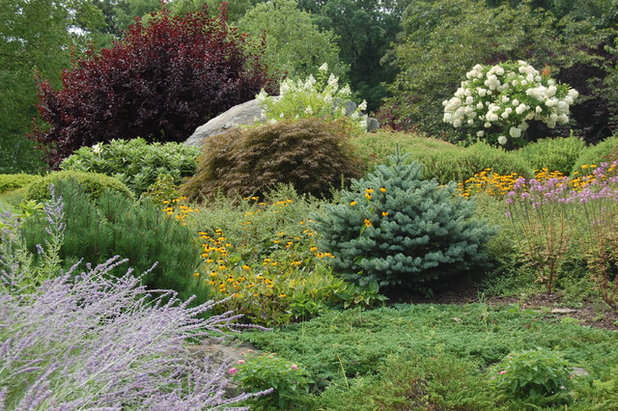
Mary-Liz Campbell Landscape Design
My experience as a landscape designer has shown me that opposites really do attract. As a result, I build my gardens around the concept of juxtaposition. Consider these four characteristics: size, color, shape and texture. Playing it safe means that you match three or four of these attributes when choosing garden mates. You’re trying hard to not rock the proverbial boat, but in your doing so, your garden becomes predictable and risks being a bit boring. Being artistic and somewhat daring means that you match one or two of these attributes when creating your garden vignette and contrast the rest. You’re injecting life and planned spontaneity into your space. Not matching any of these criteria means you’re probably buying marked-down plants at the local big-box store.
Comparing and contrasting plant characteristics can seem like a daunting task at first, but once you master it, your garden will become both your palette and your playground.
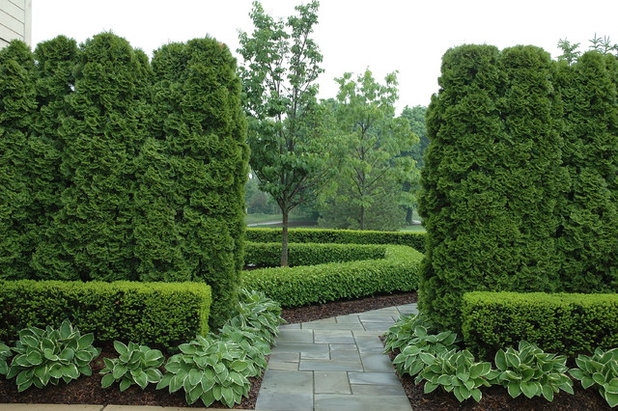
Land Architects, Inc.
Size. A memorable garden is one in which differences in heights are tastefully exploited to create a dynamic three-dimensional quality. Notice how the tall arborvitaes (
Thuja cvs, zones 4 to 8; find your zone) contrast with the shorter clipped boxwood (
Buxus sp) hedge and the hostas (
Hosta sp). The emotional impact of this nearly monochromatic garden is profound due to the thoughtful juxtaposition of size.
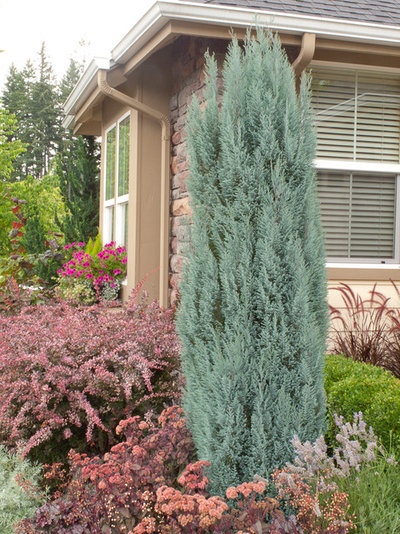
Le jardinet
Color. Color appeals to us on an artistic level. While the previous garden is sublime, some may find the green-on-green palette too restful for their personal taste. When designing a garden worthy of accolades, the color wheel can be your best friend.
When viewing the color wheel, hues directly across from each other are called complementary colors, while hues adjacent to each other are called analogous colors. Complementary colors, such as the blue and orange shown in this photo, create a high level of interest. Pairing blue with an analogous color, such as green, would create a more subdued, and some would say less interesting, vibe. The particular blue exhibited by this upright juniper has undertones of gray, as does the red in the neighboring barberry. This creates a secondary connection that speaks to the quality of this design.
See more of this Pacific Northwest garden
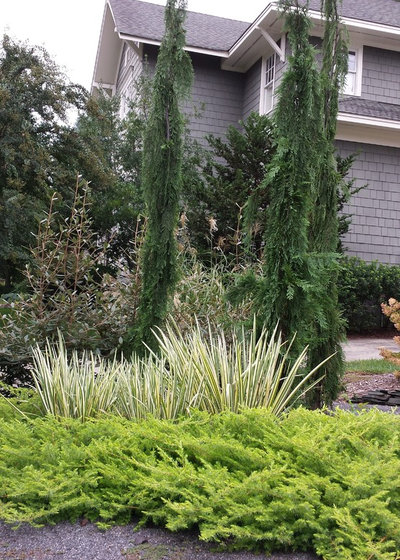
Jay Sifford Garden Design
Consider shape. Whereas size appeals to us on an emotional level, shape reaches us on an intellectual, almost empirical, level. Notice how the variegated Japanese water iris (
Iris ensata ‘Variegata’, zones 5 to 9) injects interest into this vignette while providing a point of transition between conifers. The light, vibrant hues of the iris foliage speak to the bright, spring-like hues of the Golden Pacific shore junipers (
Juniperus conferta ‘Golden Pacific’, zones 6 to 8). The shapes, however, contrast. The iris is quite vertical, while the juniper exhibits horizontal growth. The shape of the iris foliage does, however, mimic the shape of the much taller Alaskan cedar (
Chamaecyparis nootkatensis ‘Van Den Akker’, zones 5 to 8), effectively pulling the garden together.
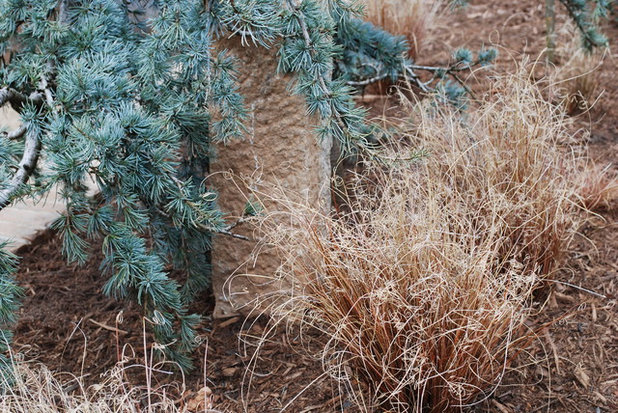
Jay Sifford Garden Design
Consider texture. Texture appeals to us on a tactile level. Well-designed gardens generally have a lot of texture. Notice how the two plants shown here, a Blue Cascade atlas cedar (
Cedrus atlantica ‘Blue Cascade’, zones 6 to 9) and Toffee Twist hair sedge (
Carex flagellifera ‘Toffee Twist’, zones 7 to 10), couldn’t be more different in size, shape and color. It is the similarity of texture that ties them together. Their texture in common begs the garden visitor to reach out and touch.
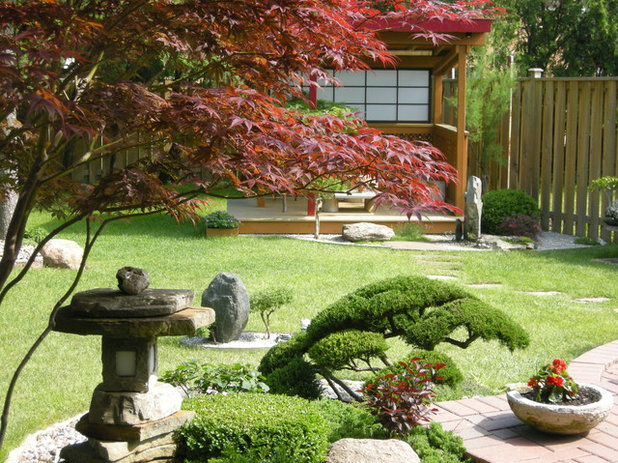 Companion Plants to Consider
Companion Plants to Consider
Japanese maples. People who are attracted to conifers are also generally attracted to Japanese maples (
Acer palmatum cvs, zones 5 to 8). The marriage couldn’t be more perfect. Both score high with regard to color and size, and are particularly appealing in form. This is why both have been used in Asian gardens for centuries.
Japanese maples are available in upright, mounding, weeping and even prostrate forms in red, orange, green, pink and white variegation. With thousands of cultivars available, there is a Japanese maple to pair with every conifer.
See 11 Japanese maples with breathtaking colors and forms
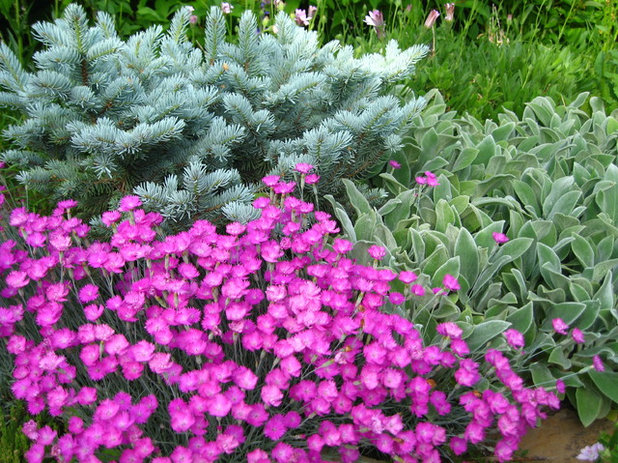
Garden Creations, Inc.
Flowering perennials. Referencing the color wheel will provide guidance to effectively pair flowering perennials with your conifer(s). Notice how the pairing of blue spruce (
Picea pungens cvs, zones 4 to 7) and Firewitch cheddar pinks (
Dianthus ‘Feuerhexe’, zones 3 to 8) here is especially appealing. The blue-gray foliage of this dianthus nearly matches that of the spruce, while the pink adds punch.
When planting perennials in close proximity to conifers, keep in mind that taller perennials can shade lower portions of the tree, causing brown patches and dieback. Shorter perennials may be a safer choice.
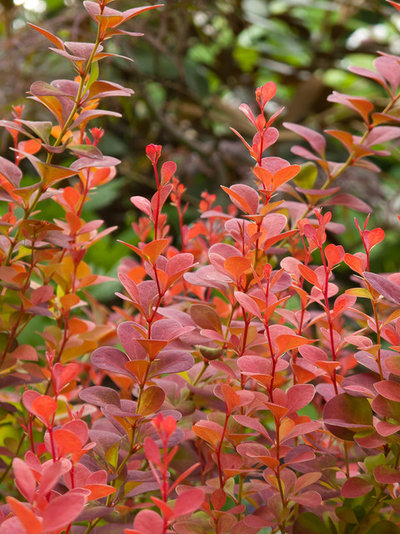
Le jardinet
Shrubs. Colorful foliage is what sets newer shrub cultivars apart from older ones and what makes them perfect bedmates for conifers. This Orange Rocket barberry (
Berberis thunbergii ‘Orange Rocket’, zones 4 to 9; check for invasiveness in your area) would be an inspired alternative for pairing with the blue spruce in the previous photo, since orange and blue are complementary (opposite) hues on the color wheel.
Additional shrubs to consider for your garden pairings include weigela
(Weigela cvs, zones 4 to 8), ninebark (
Physocarpus cvs, zones 3 to 8), boxwood (
Buxus cvs, zones 5 to 8) and smokebush (
Cotinus coggygria cvs, zones 5 to 9).
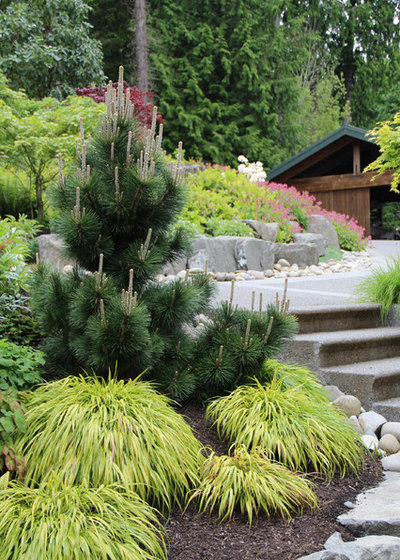
Bliss Garden Design
Grasses. These plants are virtually unsurpassed with regard to shape and texture. Many of the newer cultivars offer a wide range of colors. This low and mounding Japanese forest grass (
Hakonechloa macra ‘Aureola’, zones 5 to 9) contrasts perfectly with the Thunderhead pine (
Pinus thunbergii ‘Thunderhead’, zones 5 to 10). From sedge to switchgrass, there’s a grass or relative to pair with every conifer.
More in this series exploring conifers: Shapes | Colors | Textures | Sizes





